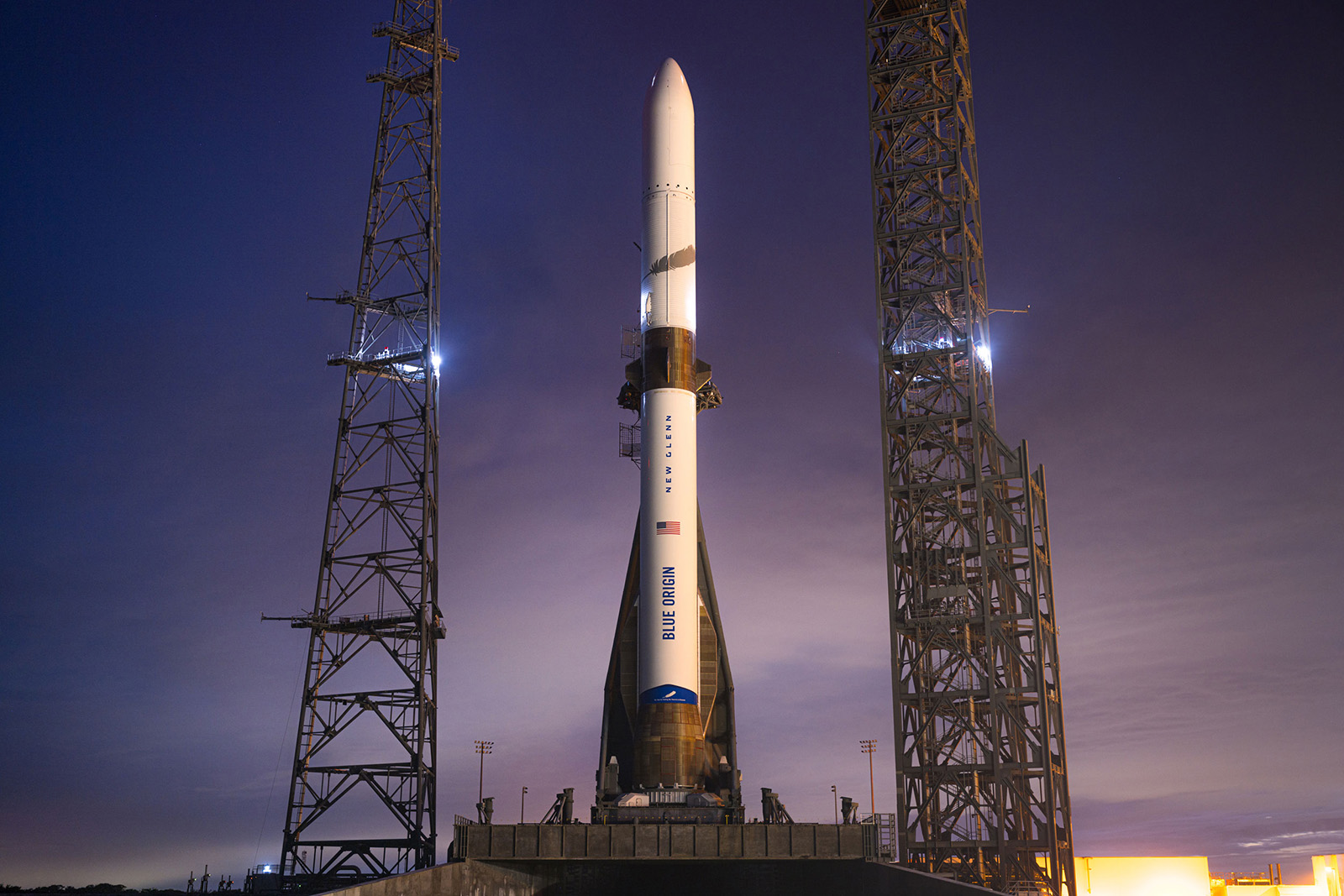Stay Up to Date
Submit your email address to receive the latest industry and Aerospace America news.
Inaugural launch of heavy-lift rocket could establish Blue Origin as a welcome competitor to SpaceX, ULA for national security launches
For launch updates, see Blue Origin’s website.
Latin is a dead language, but Blue Origin has made two Latin words famous in the space industry: “gradatim ferociter,” or “step by step, ferociously.”
The company’s most ferocious step yet in the rocket marketplace will be attempted as soon as weather and the technology permits. Blue scrubbed the original Jan. 10 window “due to a high sea state in the Atlantic” at the booster landing zone.
At pad 36 at Cape Canaveral Space Force Station stands New Glenn, a 98-meter-tall space launch vehicle of a design that has never left the ground before. Aboard is a pathfinder version of Blue Ring, a logistics spacecraft that would stay in orbit to ferry payloads to their destination orbits and refuel other spacecraft.
“This New Glenn is not launching crew anytime soon, and therefore [the inaugural launch] is lower stakes” than the company’s other big debut, the 2021 launch of a New Shepard capsule with people aboard for the first time, says astrophysicist Laura Forcyzk, founder of the Georgia consulting firm Astralytical. “But they still want to succeed so they can prove to the market that it is safe and reliable.”
By the market, she means those who buy rides to space for commercial satellites and, perhaps most importantly, military satellites and spy satellites, given the high number of opportunities through fiscal 2029 for these national security launches. SpaceX has dominated that market ever since Elon Musk elbowed his company’s way in by settling a lawsuit against the Air Force, which at the time was responsible for selecting launch vehicles for the Pentagon and National Reconnaissance Office.
If the New Glenn launch is successful, Blue would be one step closer to joining United Launch Alliance in competition with SpaceX for those launches.
Forczyk sees additional pressure for New Glenn to succeed, given the delays ULA has experienced in getting its Vulcan Centaur rockets approved for national security launches.
Also, national security leaders do not like to be single-string on rocket launches, and recent history shows why. SpaceX’s Falcon 9s were briefly grounded by FAA three times between July and October due to malfunctions, including a liquid oxygen leak in a second stage that prevented the payloads from reaching their target altitudes. In all cases, SpaceX was cleared to return to flight in a matter of days, but Ryan Puleo, an analyst with Virginia-based BryceTech, says the groundings nevertheless highlight the importance of having “a diversified array of options.”
So far, development of New Glenn has been more step-by-step than ferocious. The debut was originally targeted for 2020 but repeatedly slipped, partly due to delays in developing the BE-4 engines, seven of which are needed for each New Glenn booster. An additional delay in building the engines for the first New Glenn came when ULA contracted Blue to sell its first two BE-4s to ULA for the Vulcan booster.
Blue’s potential customers are ready for the ferocious step. Expectations that objectives will be met have risen, given New Glenn’s 10-year development timeline, says Puleo. The top objectives: Send New Glenn’s second stage and Blue Ring to orbit, then fly the booster back for a vertical landing on a landing platform in the Atlantic Ocean. Blue hasn’t elaborated on the trajectory for the second stage, but said in a press release that Blue Ring will remain attached for the entire flight.
“They have customers waiting, so they have to start making progress,” Puleo says. By customers, he’s referring in part to a handful of internet megaconstellation builders, including Amazon’s Project Kuiper — another Jeff Bezos-owned venture. Kuiper’s license from the Federal Communications Commission requires 1,600 of the planned 3,236 satellites to be orbited by July 2026, and the company has booked 12 New Glenn launches with the option for 15 more.
After 10 years, “it’s the ‘show me’ phase now,” Puleo adds.
If past is prologue, that extended development phase could recede quickly into memories, with only the ferocious ignition of New Glenn’s seven BE-4 engines emblazoned in the mind of the market. That would not be unlike the first launch of a New Shepard rocket and capsule with people aboard in 2021. Most memorable is Bezos’ broad smile and high-five to the nearest Blue employee when he stepped out of the capsule after riding to the fringes of space with three others. That flight came three years after the original target. Now, New Shepards have carried nearly 200 payloads and 50 people on suborbital jaunts, most recently six people in November. The delay is hardly discussed.
If Blue can prove New Glenn’s safety and reliability, Puleo sees the design as well-positioned to fill a gap in the heavy-lift market. Its “two main differentiators” are a 7-meter-diameter fairing, and the ability to send 45 metric tons to low-Earth orbit. That extra fairing volume means New Glenn can hold spacecraft with “unique dimensions” that don’t fit in the roughly 5-meter fairings of Falcons and Vulcans, Puleo says, and also launch more spacecraft at a time. For instance, Blue Origin’s former CEO Bob Smith told CNBC in 2022 that each New Glenn can carry 61 Kuiper satellites. That’s compared to 45 satellites per Vulcan Centaur, which is designed to send 25 metric tons to LEO. Kuiper has also ordered 38 Vulcan launches to help deploy its constellation.
With that larger fairing, New Glenn could potentially “capture the market that is waiting for Starship,” Forczyk observes, referring to its 9-meter-diameter fairing and 150-metric-ton capacity in fully expendable mode.
Let’s suppose that New Glenn’s first flight doesn’t go as planned, though. Phil Smith, another launch analyst at BryceTech, predicts that “the market will be pretty forgiving.”
“Blue Origin’s established pretty good credibility with the New Shepard, the success with that system,” he says.
Forczyk also predicts that a failure “wouldn’t be devastating,” but she would expect a long delay before the next New Glenn lifts off. “Blue Origin is not a quick company. They will take a long time to turn that around.”
About cat hofacker
Cat helps guide our coverage and keeps production of the print magazine on schedule. She became associate editor in 2021 after two years as our staff reporter. Cat joined us in 2019 after covering the 2018 congressional midterm elections as an intern for USA Today.
Related Posts
Stay Up to Date
Submit your email address to receive the latest industry and Aerospace America news.




